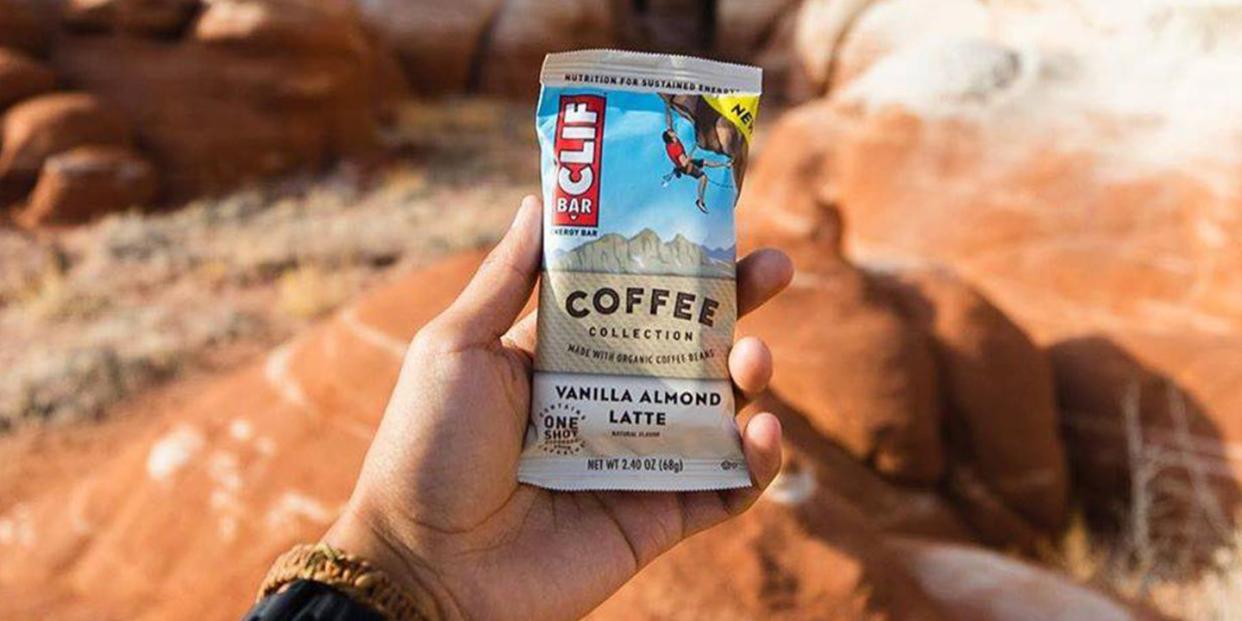Yes, Clif Bars Are a Healthy Option — Just Make Sure Your Are Eating Them at the Right Time

"Hearst Magazines and Yahoo may earn commission or revenue on some items through the links below."
It only takes one bonk for you to learn how important it is to fuel your rides with the right nutrients. Grab-and-go pocket foods work wonders for this, and when you walk down the energy bar aisle in the grocery store, one name you’re sure to recognize is Clif Bar. But are Clif Bars healthy for you?
The brand that was “born on the bike” has built a reputation for having the right ingredients to fuel your body during any type of ride—from those long, tough ones to the short and sweet variety. But even still, you want to know everything about what’s in your bar before you rely on it for the long haul. So we turned to Mascha Davis, a Los Angeles-based registered dietitian and creator of Nomadista Nutrition, and Jessica Chon, a registered and board certified sports dietitian and nutritionist and nutrition scientist at Clif Bar, for all the details you need to know.
Join Bicycling now for the latest health tips!
A Clif Bar Nutrition Breakdown:
One chocolate chip Clif Bar, one of the most popular flavors, contains the following:
260 calories
43 grams of carbohydrates
10 grams of protein
17 grams of sugar
6 grams of fat
When it comes to ingredients, this bar contains: Organic Rolled Oats, Organic Brown Rice Syrup, Soy Rice Crisps (Soy Protein Isolate, Rice Flour, Barley Malt Extract), Organic Roasted Soybeans, Organic Tapioca Syrup, Organic Cane Syrup, Unsweetened Chocolate, Chicory Fiber, Organic Soy Flour, Organic High Oleic Sunflower Oil, Natural Flavors, Sea Salt, Organic Cinnamon, as well as a variety of essential vitamins and minerals.
A bar that’s high in carbohydrates gives your muscles the energy they need to keep pedaling, and Chon says that Clif Bars—no matter which flavor you choose—contain a blend of complex carbs for sustained energy and simple carbs that your body is able to break down quickly for immediate energy. Protein and fat are major fuel sources as well, which balance the carbs out, she says.
Davis adds that when doing endurance activities, your body needs more readily-available energy, which is why this bar is packed with 17 grams of sugar—it digests fast enough to give you a boost when you need it most. It’s important to point out that all sugar is not created equal. The source of sugar here is organic brown rice syrup, organic tapioca syrup, and organic cane syrup, not high-fructose corn syrup, which our bodies have not evolved to process effectively and can easily be converted to fat.
Clif Bars also contains minerals such as phosphorus and magnesium to improve aerobic capacity and help your muscles contract.
Is It Bad to Eat a Clif Bar Every Day?
Because Clif Bars contain a higher amount of carbs and sugar, they’re not an ideal healthy snack for all circumstances. Chon recommends eating a Clif Bar before or during moderate- to high-intensity activity when you need sustained energy. After that 45-minute Spin class? Not so much. Our bodies generally have enough fuel stored in our muscles for efforts under 60 minutes. And consuming too much sugar too often can lead to conditions such as obesity or diabetes.
That said, there are plenty of other bars to suit different needs. Skratch Anytime bars can be eaten—you guessed it—anytime, thanks to the low sugar content (just 4 to 7 grams depending on the flavor) and plant-based ingredients that are easy to digest.
Other protein bars such as RX Bar are a good option specifically for recovery because they have 12 grams of protein and 13 to 15 grams of natural sugar to help repair your muscles postworkout.
While you might be tempted to have a Clif Bar as a midday snack—they’re just so quick and easy!—Davis cautions that this isn’t the best choice, nutritionally-speaking. “Clif Bars are high in added sugars and are usually meant for endurance athletes,” she says. Instead, Davis suggests going for whole foods such as fruits and veggies paired with dips or nut butters, trail mix, or yogurt. These options have fewer simple carbs and sugars.
Are Clif Bars a Healthy Meal Replacement?
Conversely, Clif Bars shouldn’t be treated as a meal replacement either. According to the Office of Disease Prevention and Health Promotion, a healthy meal should include vegetables, whole grains, proteins, and healthy fats. And given that a Clif Bar is only 260 calories, it’s not enough food to count as a full meal for an active individual.
Of course, when you’re in a pinch, a Clif Bar is a better option than say, a candy bar, but again, you may want to consider a bar with less sugar as an alternative snack and supplement with whole foods if possible.
[Want to fly up hills? Climb! gives you the workouts and mental strategies to conquer your nearest peak.]
In the end, Clif Bars are a healthy option during moderate to intense exercise that lasts more than an hour when you need to fuel your muscles for extra energy. Outside of exercise, opt for a bar with less sugar or ideally, whole food snacks and meals.
You Might Also Like

